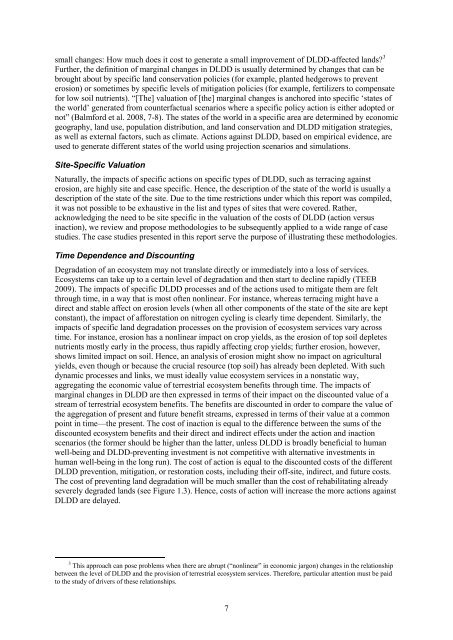The Economics of Desertification, Land Degradation, and Drought
The Economics of Desertification, Land Degradation, and Drought
The Economics of Desertification, Land Degradation, and Drought
Create successful ePaper yourself
Turn your PDF publications into a flip-book with our unique Google optimized e-Paper software.
small changes: How much does it cost to generate a small improvement <strong>of</strong> DLDD-affected l<strong>and</strong>s? 3<br />
Further, the definition <strong>of</strong> marginal changes in DLDD is usually determined by changes that can be<br />
brought about by specific l<strong>and</strong> conservation policies (for example, planted hedgerows to prevent<br />
erosion) or sometimes by specific levels <strong>of</strong> mitigation policies (for example, fertilizers to compensate<br />
for low soil nutrients). “[<strong>The</strong>] valuation <strong>of</strong> [the] marginal changes is anchored into specific ‘states <strong>of</strong><br />
the world’ generated from counterfactual scenarios where a specific policy action is either adopted or<br />
not” (Balmford et al. 2008, 7-8). <strong>The</strong> states <strong>of</strong> the world in a specific area are determined by economic<br />
geography, l<strong>and</strong> use, population distribution, <strong>and</strong> l<strong>and</strong> conservation <strong>and</strong> DLDD mitigation strategies,<br />
as well as external factors, such as climate. Actions against DLDD, based on empirical evidence, are<br />
used to generate different states <strong>of</strong> the world using projection scenarios <strong>and</strong> simulations.<br />
Site-Specific Valuation<br />
Naturally, the impacts <strong>of</strong> specific actions on specific types <strong>of</strong> DLDD, such as terracing against<br />
erosion, are highly site <strong>and</strong> case specific. Hence, the description <strong>of</strong> the state <strong>of</strong> the world is usually a<br />
description <strong>of</strong> the state <strong>of</strong> the site. Due to the time restrictions under which this report was compiled,<br />
it was not possible to be exhaustive in the list <strong>and</strong> types <strong>of</strong> sites that were covered. Rather,<br />
acknowledging the need to be site specific in the valuation <strong>of</strong> the costs <strong>of</strong> DLDD (action versus<br />
inaction), we review <strong>and</strong> propose methodologies to be subsequently applied to a wide range <strong>of</strong> case<br />
studies. <strong>The</strong> case studies presented in this report serve the purpose <strong>of</strong> illustrating these methodologies.<br />
Time Dependence <strong>and</strong> Discounting<br />
<strong>Degradation</strong> <strong>of</strong> an ecosystem may not translate directly or immediately into a loss <strong>of</strong> services.<br />
Ecosystems can take up to a certain level <strong>of</strong> degradation <strong>and</strong> then start to decline rapidly (TEEB<br />
2009). <strong>The</strong> impacts <strong>of</strong> specific DLDD processes <strong>and</strong> <strong>of</strong> the actions used to mitigate them are felt<br />
through time, in a way that is most <strong>of</strong>ten nonlinear. For instance, whereas terracing might have a<br />
direct <strong>and</strong> stable affect on erosion levels (when all other components <strong>of</strong> the state <strong>of</strong> the site are kept<br />
constant), the impact <strong>of</strong> afforestation on nitrogen cycling is clearly time dependent. Similarly, the<br />
impacts <strong>of</strong> specific l<strong>and</strong> degradation processes on the provision <strong>of</strong> ecosystem services vary across<br />
time. For instance, erosion has a nonlinear impact on crop yields, as the erosion <strong>of</strong> top soil depletes<br />
nutrients mostly early in the process, thus rapidly affecting crop yields; further erosion, however,<br />
shows limited impact on soil. Hence, an analysis <strong>of</strong> erosion might show no impact on agricultural<br />
yields, even though or because the crucial resource (top soil) has already been depleted. With such<br />
dynamic processes <strong>and</strong> links, we must ideally value ecosystem services in a nonstatic way,<br />
aggregating the economic value <strong>of</strong> terrestrial ecosystem benefits through time. <strong>The</strong> impacts <strong>of</strong><br />
marginal changes in DLDD are then expressed in terms <strong>of</strong> their impact on the discounted value <strong>of</strong> a<br />
stream <strong>of</strong> terrestrial ecosystem benefits. <strong>The</strong> benefits are discounted in order to compare the value <strong>of</strong><br />
the aggregation <strong>of</strong> present <strong>and</strong> future benefit streams, expressed in terms <strong>of</strong> their value at a common<br />
point in time—the present. <strong>The</strong> cost <strong>of</strong> inaction is equal to the difference between the sums <strong>of</strong> the<br />
discounted ecosystem benefits <strong>and</strong> their direct <strong>and</strong> indirect effects under the action <strong>and</strong> inaction<br />
scenarios (the former should be higher than the latter, unless DLDD is broadly beneficial to human<br />
well-being <strong>and</strong> DLDD-preventing investment is not competitive with alternative investments in<br />
human well-being in the long run). <strong>The</strong> cost <strong>of</strong> action is equal to the discounted costs <strong>of</strong> the different<br />
DLDD prevention, mitigation, or restoration costs, including their <strong>of</strong>f-site, indirect, <strong>and</strong> future costs.<br />
<strong>The</strong> cost <strong>of</strong> preventing l<strong>and</strong> degradation will be much smaller than the cost <strong>of</strong> rehabilitating already<br />
severely degraded l<strong>and</strong>s (see Figure 1.3). Hence, costs <strong>of</strong> action will increase the more actions against<br />
DLDD are delayed.<br />
3 This approach can pose problems when there are abrupt (“nonlinear” in economic jargon) changes in the relationship<br />
between the level <strong>of</strong> DLDD <strong>and</strong> the provision <strong>of</strong> terrestrial ecosystem services. <strong>The</strong>refore, particular attention must be paid<br />
to the study <strong>of</strong> drivers <strong>of</strong> these relationships.<br />
7

















